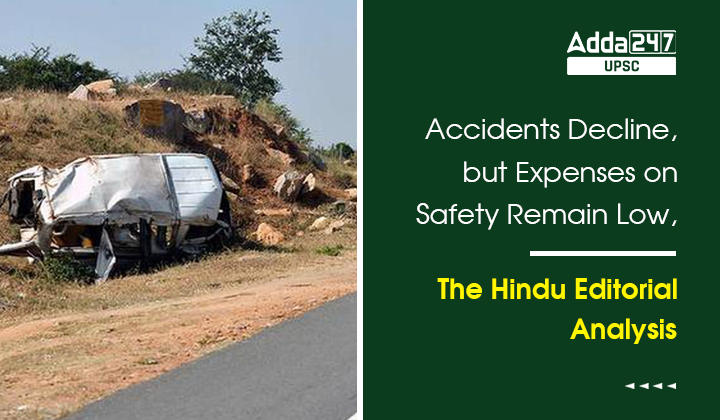Table of Contents
The Hindu Editorial Analysis: The Editorial Analysis of The Hindu Newspaper Editorial Articles aimed at simplifying various concepts relevant to the UPSC and other State PSC Exams. The Editorial Analysis helps in expanding the knowledge base as well as framing better quality mains answers. Today’s Hindu Editorial Analysis of ‘Accidents Decline, but Expenses on Safety Remain Low’ discusses railway accidents in India over the period of time and what measures and funding has been there on the measures ensuring safety against rail accidents. This ‘The Hindu Editorial’ is relevant in the context of recent Rail Accident in Odisha resulting in death of hundreds of people.
Railway Accidents in News
An initial examination of historical data regarding railway accidents suggests that such occurrences have become less frequent over time. In the 1960s, the Indian Railways experienced an average of approximately 1,390 accidents annually. However, this number has significantly decreased to an average of 80 accidents per year in the past decade. Despite this positive trend, the recent triple-train collision in Balasore, Odisha, which stands as one of the most devastating incidents in India, raises concerns about the safety of rail travel.
Train Accidents Definition
Train accidents refer to consequential train accidents: those that resulted in loss of human life, loss of railway property, caused injuries, and interrupted rail traffic. Derailments formed close to 70% of all accidents since 1990-91, followed by level crossing accidents, collisions and fires in trains
Consequential Train Accidents
The tragic incident in Odisha, which resulted in the loss of at least 275 lives, is particularly noteworthy. The number of fatalities in this single incident surpasses the combined annual death toll from consequential train accidents in the past 16 years.
- Notably, the Indian Railways reported zero fatalities in 2019-20 and 2020-21 as a result of consequential accidents.
- However, in 2020, during a discussion with the NITI Aayog chief, it was highlighted that around 30,000 individuals had lost their lives over a three-year period due to trespassing and other unfortunate incidents around railway premises.
- The Railways responded by stating that it cannot control casualties resulting from trespassing or negligence on the part of passengers, emphasizing efforts to raise public awareness and sensitization.
Causes of Consequential Train Accidents
It is worth noting that a significant portion of consequential train accidents, approximately 55%, can be attributed to negligence or failures on the part of Railway staff.
- Around 28% of accidents were found to be caused by individuals other than Railway staff, while 6% were attributed to equipment failures.
- In the case of the Balasore tragedy, a preliminary investigation has indicated a potential failure of the signalling system as a contributing factor.
Major Causes of Derailment
Rail fractures, weld failures, track defects, and rolling stock defects are the major causes of derailments. The Ministry of Railways recognizes that the track is the crucial foundation of the railway transportation system and must be maintained with safety as a top priority.
- According to a Ministry white paper, it is recommended that 4,500 km of track be renewed each year.
- However, data reveals that the target set by the Railways is consistently lower than the level proposed in the white paper.
- Over the past seven years, with the exception of one year, the Railways has been unable to achieve this recommended level of track renewal.
Union Budget Expenditure on Railway Safety
The Union Budget for the year 2023-24 allocated a record-breaking amount of ₹2.40 lakh crore to the Railways.
- However, when examining the capital expenditure specifically designated for critical safety-related activities such as track renewal, signalling, and telecom, their respective shares have either declined or remained stagnant in recent years.
- In terms of the budgetary support for capital expenditure, the allocation for track renewal has dropped to 7.2%, while expenditure proposed for signalling has remained at 1.7% for FY24.
Rashtriya Rail Sanraksha Kosh (RRSK) Fund
In the fiscal year 2017-18, the Rashtriya Rail Sanraksha Kosh (RRSK) fund was established with a corpus of ₹1 lakh crore.
- The primary objective of this fund was to provide financial assistance for crucial safety-related projects and to address accidents, including those occurring at unmanned level crossings.
- However, a report from the Parliamentary Standing Committee in March 2023 highlighted that the appropriations to the RRSK have consistently fallen short since its inception.
- Additionally, the Committee observed that the Railways failed to meet the earmarked allocation targets for the previous five years.
Is India Missing the Graphene Bus?, The Hindu Editorial Analysis
| Follow US |
| UPSC Govt Jobs UPSC Current Affairs UPSC Judiciary PCS Download Adda 247 App here to get the latest updates |



 TSPSC Group 1 Question Paper 2024, Downl...
TSPSC Group 1 Question Paper 2024, Downl...
 TSPSC Group 1 Answer key 2024 Out, Downl...
TSPSC Group 1 Answer key 2024 Out, Downl...
 UPSC Prelims 2024 Question Paper, Downlo...
UPSC Prelims 2024 Question Paper, Downlo...
